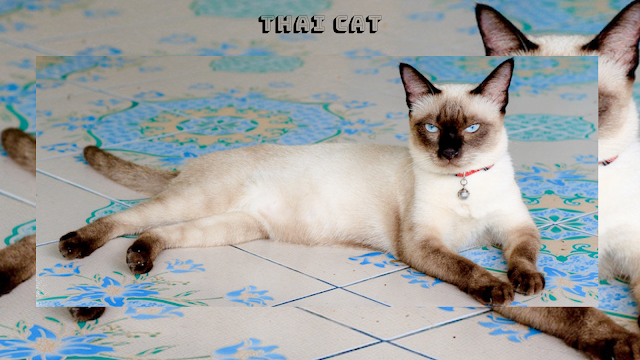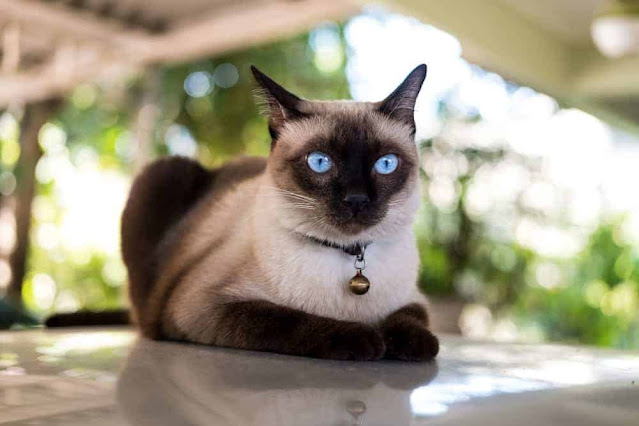History
As breeding of the modern Siamese started producing a more
slimline, long-legged body shape, requests for old-style Siamese cats started
to increase. Many breeders and cat fanciers preferred a rounder, sturdier build
for their cats, which is how the Thai cat came to be. The goal was to preserve
the original Thai ‘masked cat‘. Once widely known as old-style Siamese, the
breed is now known as Thai and recognised by the TICA pedigree cat registry. In
Thailand the breed is known as “Wichienmaat“. The origins of the Thai breed are
found in the Siamese. Both breeds come from the region formerly known as Siam,
in modern-day Thailand. The Wichienmaat, a domestic cat with distinctive point
colouring and bright blue eyes, has been a treasured pet in this region for
over 700 years. Sailors and colonists brought the first Siamese to England and
the USA at the end of the 18th Century. Their appearance aroused a great deal
of curiosity, especially because of the Siamese cat that was displayed at the Crystal
Palace in 1871. King Chulalongkorn of Siam gave a breeding pair of Siamese to
the British Consul General as a gift in 1884, and this is generally recognised
as the official start of Siamese breeding in Europe. The breeding pair were
named Pho and Mia. In 1892 the first breed standards of the “Royal Cat of Siam”
were laid down, and this was followed by the formation of the English Siamese
Cat Club in 1901.
Body
Than the Siamese cat, Thai Cat has a milder, more natural
appearance with balanced proportions. The elegant body is medium in size,
robust and well-muscled. The limbs are relatively long in relation to the body.
The head is rounded, with a profile without a bend or a trace. Medium-sized
ears are set further apart. Big eyes
Colour variants
The Thai Cat is typical in the Himalayan´s colouring. There
are several colour varieties, the most common being black-brown with the
seal-point and blue with the blue-point. It is also a chocolate with badges
(chocolate-point), lilac with badges (lilac-point) and red with badges
(red-point). These colours can also be with the tabby point. Eyes have intense
blue colour.
Personality
First of all, the Thai is a very people-focused feline.
These cats will often follow the humans of a household around from room to room
as they seek out company. The Thai is also a very vocal breed of cat, with many
owners insisting that their Thai cats talk to them to let them know how they're
feeling! They're also inquisitive and curious creatures who love to explore the
world around them, so living in a home with lots of safe climbable furniture
would be a bonus.
Just be warned that, due to the Thai's very sociable nature,
they are cats who definitely need what might seem like constant attention. If
you have a household with young children, that's great, as the Thai will
happily become like a new best friend and play buddy to your kids.
Temperament
The Thai is a vocal cat that likes to talk and never tires
of the sound of her voice. So, your cat will greet you by the front door and
immediately start talking about her day and other things of importance. This is
a highly social breed that demands constant attention and a lot of affection.
In fact, they will often make it a point to follow you around and get involved
in everything that you do to remind you of their presence.
This is a social breed that likes meeting new people and
basks in the attention it receives. However, they are very attached to their
owners and won’t appreciate being left at home all alone. Hence, they are best
suited for people who spend a lot of time at home.
Grooming
When it comes to grooming, the short-haired Thai cat is
pretty low maintenance and will be good with weekly brushing sessions. This
will help ward off the chances of any mats forming. Although, ask your vet for
tips if you find that your Thai doesn't take to sitting still and being brushed
at first. In terms of climate, most Thais are fairly adaptable felines, but
they do tend to prefer warmer rather than colder places to live. Just remember
to always make sure that there's enough shade and fresh water available during
the hotter months.
Compatibility with Children and Other Pets
The social and attention seeking Thai Cat is an ideal choice
for families with children. These cats love to chase after feather teasers and
will play with any child that can match their energy levels. They also get
along with other cats and cat-friendly dogs. However, they form deep bonds with
their owners and can become jealous of other pets. So do your best to provide
the same amount of affection to all pets, so that you won’t have to justify
yourself to this demanding feline.
The Thai likes to play and never passes the opportunity to
interact with its owner. So keep your cat entertained with catnip toys and
indulge her in a game of fetch. Try spending at least 15 minutes a day playing
with your cat to keep her happy. And for when you aren’t around, get your cat a
ball tower to help her pass the time.
Share with Your Friend..
Reference
https://www.zooplus.co.uk/magazine/cat/cat-breeds/thai-cat
https://brit-petfood.com/en/breed-catalog/siamese-and-oriental-cats/thai-cat

















No comments:
Post a Comment